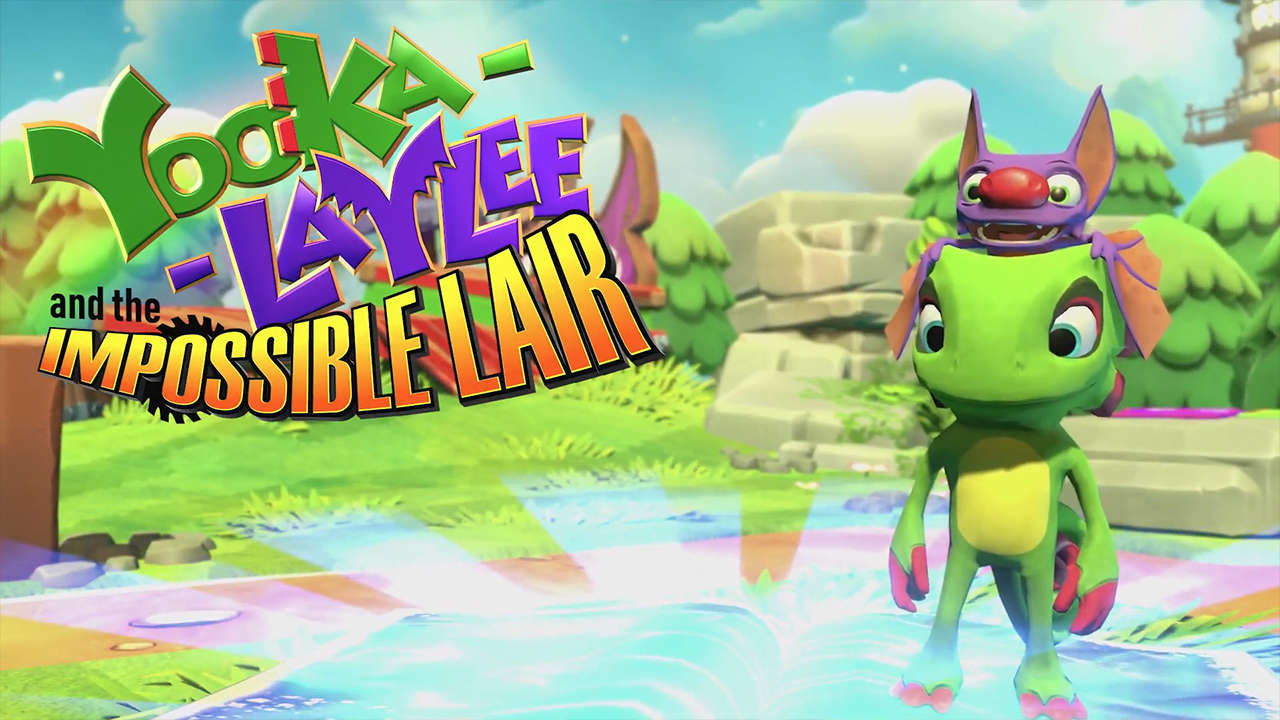Lucky me got to grow up during a golden age of video games. Although I was too young to really own a console at the time, my youngest years were spent playing NES with different cousins, all the while borrowing another cousin’s Atari 2600. When I got a bit older, and my love for video games became obvious, a Super Nintendo of my very own followed. Then, after that came a lime green Game Boy Colour, with Mario Golf and Link’s Awakening, and a black N64 with Diddy Kong Racing. During these years, I’d jump between systems, and absolutely adored what are now classic platformers, like Super Mario Bros. 1-3, Banjo-Kazooie, Super Mario World, and the Donkey Kong Country trilogy.
Due to the above, it’s no wonder that, when I first heard about Yooka-Laylee I became pretty excited. After all, those types of games have become less and less common these days, especially outside of the indie scene. With Yooka-Laylee, Team17 promised the return of the classic buddy platformer, and a 3D one no less. It oozed Banjo-Kazooie, and brought great memories to mind every time I watched gameplay or wrote a news post.
Unfortunately, the original game didn’t end up being what I had hoped and wanted it to be, which led to me abandoning it after quite a few hours. I became fatigued by the bland missions, the lacking environments, the poor boss battles and the cumbersome gameplay, and simply had had my fill by the time I decided to drop it. That is something I rarely do, too, and had debated for some time before doing so. In fact, I kept pushing myself to play the game more and more, in the hopes that something would make me fall in love and want to continue. That never did happen, though.
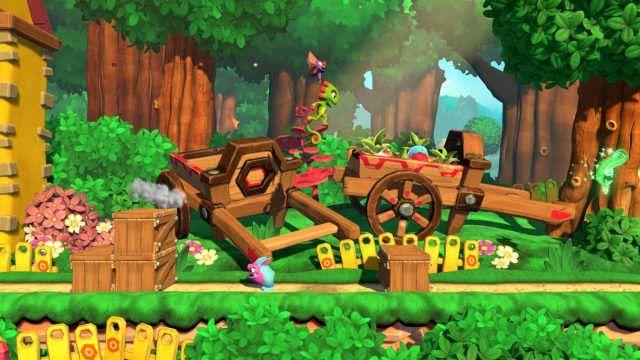
Fast-forward to today, and I find myself having been given a second chance to fall in love with the colourfully designed bat and lizard. The duo is back in a brand new, and different game, which goes by the name of Yooka-Laylee and the Impossible Lair, and has good reason for doing so. Things are different this time around, as instead of borrowing from and paying modern homage to 3D platformers like Banjo-Kazooie and Donkey Kong 64, The Impossible Lair takes inspiration from the more traditional platformers that hooked me the most during my younger years. After all, Donkey Kong Country was my absolute favourite game back then, and every time a new one came out I’d count the days until Christmas, and would have a hard time leaving the screen afterwards.
Things begin in said Impossible Lair, where our heroes must attempt to help Queen Phoebee defeat the nefarious Capital B and his evil underlings. The twist is that you’re supposed to die, but simply don’t know it at the time. As you try and try to best the lengthy and difficult level, you’ll encounter more and more challenging platforming and opposition, leading to an expected death. At least, that’s what’s supposed to happen. Anyone who is able to beat this stage during their first attempt deserves recognition, because it’s a beast to put it simply.
After you fail to best Capital B’s special stage, you’ll find yourself in a 2.5D over world, which acts as an interactive map. There, you’ll be told to scour the world, in an attempt to free nearly fifty different members of the Queen’s Beetallion. Doing so will give you a fighting chance against the Impossible Lair, because each new bee acts as a shield of sorts. Thus, your best bet is to save all of them, or at least as close to that amount as possible. Even then, you’ll likely still have a difficult time attempting the last stage and final boss. It’s a masochistic endeavor, which is designed to be challenging, to encourage repeat attempts. The problem is that this design creates frustration, especially when said level is over twenty minutes long and doesn’t offer checkpoints, continues or any sort of power-up.
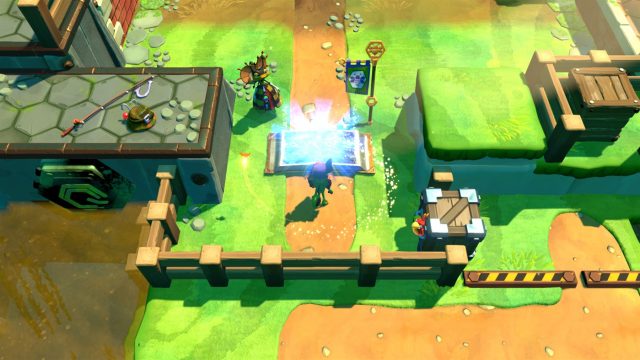
Hell, it’s almost like a rogue-like or Soulsborne take on platforming. And, as someone who doesn’t enjoy playing any of those games, I wish this wasn’t the case, because it is a deterrent for anyone who buys games wanting to beat them. Yooka-Laylee and the Impossible Lair will simply be too difficult for all players to beat, and while I know that games aren’t designed to be easy to finish, I’ve read numerous accounts about people who’ve been good enough to save all of the Beetallion members, just to find that the Impossible Lair is too cheap and difficult for them to finish. Thus, they can’t say that they’ve finished a game that they’ve spent quite a bit of time with, and have almost mastered. It likes to introduce new things that aren’t even prevalent in the base set of missions.
The over world offers around twenty different stages, all of which are meant to teach you how to tackle the last one. Each one is themed and, for the most part, quite well designed, leading to a quality platforming experience that does a good job of furthering the genre that it pays homage to and exists within. There’s lots of fun to be found, not to mention more polish than we saw in the last game. The controls are pretty tight, too, which limits potential frustration.
As they explore these stages, players can take advantage of the duo’s combined abilities. Jumping, rolling and swinging on vines are the basics, but when the two are together they’re able to slam downward and pull off other feats. However, as is the case with Donkey Kong Country and its more modern successors (of which Returns was kind of disappointing, whereas Tropical Freeze was great), once you get hit you lose one of the characters. If you’re hit twice, then that means death and a return to the last checkpoint that you passed. However, instead of being given your ally back through the process of throwing branded barrels, you’re able to reunite with Laylee by hitting bells that are spread throughout each stage. It’s also possible to get her back immediately after being hit, but you have to be quick and willing to risk dealing with whatever enemy or environmental hazard hurt you before. What I’m trying to say here is that, much like New Super Mario Bros. Wii and New Super Mario Bros. U, there exists a system where the lost Laylee flies around above the place she ‘died,’ and can be ‘revived’ by jumping into and collecting her again. There are no bubbles to be seen, though.
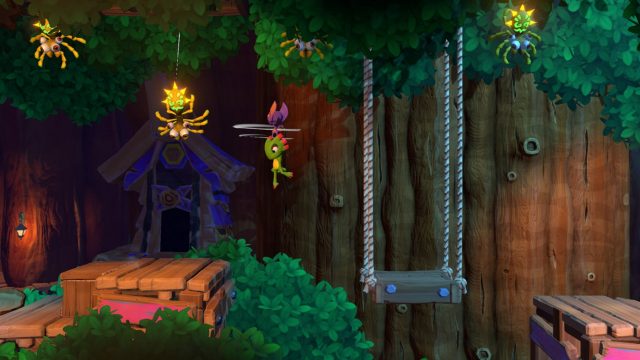
Available to be found in each stage are five different collectible coins, which just so happen to be numbered. Just like in Mario, and in other similar games, they’re either hidden in high danger areas, or placed somewhere off the beaten path. Sometimes they’re even in hidden areas, which are disguised by fake walls, or accessed by destroying a specific crate and going underneath it. It’s pretty standard platforming fare, and is almost par for the course with these things. What’s slightly different here, though, is that some secret areas require you to have both characters. If you don’t, then you won’t be able to do a downward slam into said breakable crate.
There are also lots of different quills to find, and a lot of them require some skill. For instance, you may jump on one coloured quill and then have to follow it as it twists and turns while letting out a trail of smaller quills. At other times, the game will put a few red ones in a row, or at least in an immediate area, and you’ll have to jump from one to another to complete a chain. Sometimes this is easier said than done, though, as you’d expect. After all, it’s not supposed to be easy.
The quills are important, because they can be used to pay for tips, secrets and collectibles. You can also use them to buy tonics, which act as perks or cheats. Some are just there for fun, such as the big head tonic, and the one that makes the characters pixelated. Others are helpful assists, though, and can offer extra checkpoints and other benefits. Whether or not you equip them is up to you, because they’re entirely optional and can be swapped at will, prior to entering any level.
While a lot of said stages require basic platforming, some are underwater, and the game shines in these areas. The swimming mechanics are really quite solid, and I was excited every time I saw that I’d be entering a swimming stage.
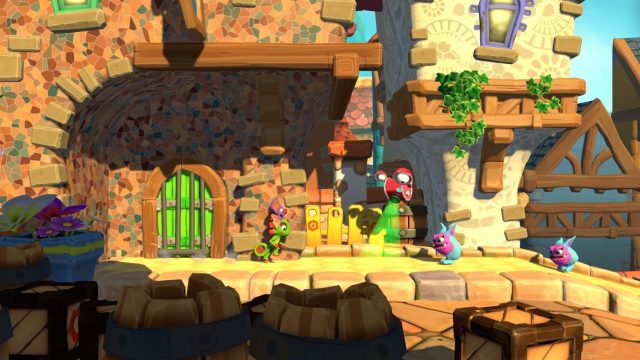
Speaking of the elements, it’s important to note something major: That is, the fact that Yooka-Laylee and the Impossible Lair‘s stages all tend to have second forms. How does this work? Well, as you explore the over world, complete its puzzles, beat its pagie challenges and uncover its secrets, which include hidden collectibles like Beetallion members, you’ll find different coloured berry bushes. There are ice berries and fire berries, and each one obviously has a different effect on nearby stages. They’re also helpful, and sometimes required, when it comes to altering the map so that you can access new areas and ledges, and simply progress.
Due to the above, a water level can be turned into an ice level, or vice versa. Simply put, you can use the elements to change a basic stage into its variant, and that gives you a chance to collect another member of the Beetallion. It also lengthens the game, and turns what reads like a small amount of levels into a much larger one. Most of all, it’s a really neat twist and gimmick, the latter of which is a word I’m using positively in this instance.
Outside of the obvious differences, these elemental changes really do make the stages feel different. They may not have changed a ton, but it feels like it, because the water or whatever adds a new challenge that wasn’t there before, and creates an often positive transformation. Then again, almost all of the levels, be they the regular versions or the elementally altered variants, were both well designed and fun, not to mention impressive. This is a quality game, and its level design is responsible for a lot of that.
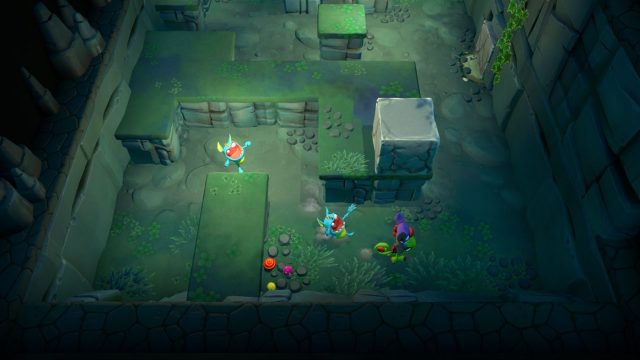
Don’t get me wrong: This isn’t up to the level of the first two or three Donkey Kong Country games, nor is it as good as Tropical Freeze. It has improved and impressed me enough to be in the conversation, though. It’s just too bad that a lot of the positives are smothered by the final stage, which should have been optional, instead of being a requirement for beating the game. Knowing that it’s there, and how sadistic it can be, makes the lead up less enjoyable. At least, if you’re someone who gets a high from beating games like I do. My favourite thing about gaming is playing through, and then finishing, a good campaign. I play single player much more than multiplayer for this reason.
As you can tell from the included screenshots, Yooka-Laylee and the Impossible Lair is a very colourful game. That was to be expected, of course, especially given how vibrant the last one happened to be. It looks even better in action, though, and is a nice treat for the eyes. The visuals have an almost Playdough look to them, but in a good way, and both the stages and over world really pop off the screen. Thankfully, things run as well as they look, at least in my experience. I can’t think of a single notable bug that I experienced during my time with the game.
The music is also quite good, and really sets the tone for the quality platforming that is found within this relatively small install file. It’s quirky, whimsical, fun and engaging, as it should be. Meanwhile, the dialogue is more of the same indistinguishable babble that games like Banjo-Kazooie were famous for. It can be annoying, but it works in this capacity. After all, it’s not as if there’s a ton of it.
If you’re looking for a good, classically styled platformer, then Yooka-Laylee and the Impossible Lair should definitely be on your short list. That is, so long as you’re okay with the fact that its final stage is a lengthy, devious and oppressing thing that should’ve been optional instead of mandatory. Those who like extra challenge need definitely apply, but the average gamer may not be as interested in this type of mechanic. The good news, though, is that the rest of the game is really solid.
This review is based on the Xbox One version of the game, which we were provided with.

